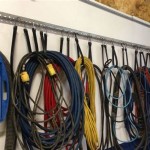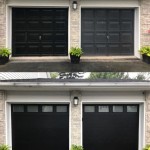DIY Hanging Garage Storage Shelves: A Guide to Maximizing Space
A cluttered garage can quickly become a source of frustration. The constant search for tools, boxes, and seasonal items can consume valuable time and add unnecessary stress. However, with a bit of DIY ingenuity, you can transform your garage into a well-organized space. Hanging garage storage shelves offer a practical solution for maximizing vertical space and keeping your belongings within easy reach. This article will guide you through the process of creating your own hanging shelves, providing step-by-step instructions and helpful tips for success.
1. Planning and Preparation
Before embarking on your DIY project, meticulous planning is essential. Carefully assess your garage's layout and the specific items you wish to store. Consider the weight of your belongings and select appropriate materials that can handle the load.
First, determine the dimensions of your hanging shelves. Measure the available space on your garage ceiling and walls, leaving ample clearance for easy access and movement. Decide on the number of shelves you need and the optimal width and depth for each. Remember to factor in the thickness of the shelving materials.
Next, choose materials that are both durable and aesthetically pleasing. For the shelf itself, consider using plywood, particleboard, or even reclaimed wood. For the hanging system, use heavy-duty brackets, preferably made of metal or sturdy plastic. Choose screws and anchors appropriate for your ceiling and wall materials. Finally, ensure you have the necessary tools, including a tape measure, level, drill, screwdriver, safety glasses, and a saw.
2. Building the Shelves
Once you have gathered your materials and tools, you can start constructing your shelves. Begin by cutting the plywood or chosen material to the desired dimensions using a saw. Sand the edges carefully for a smooth finish and to prevent splintering.
Next, attach the brackets to the underside of each shelf. If using simple brackets, ensure they are securely screwed in place. For more complex brackets, follow the manufacturer's instructions. Measure and mark locations for the brackets, ensuring they are equidistant and level for a symmetrical appearance.
If you are using multiple shelves, make sure they are evenly spaced apart. This allows for efficient use of space and easy access to all items. For added stability, consider using a support beam between the shelves, especially for heavier items. This can be accomplished by attaching a piece of wood or metal to the underside of each shelf and connecting them with a sturdy support.
3. Hanging and Securing the Shelves
The next step is to hang the shelves. First, determine the optimal location for your shelves, considering factors like accessibility and proximity to your belongings. Ensure the planned location is free of any obstructions, such as electrical wiring or plumbing.
Use a stud finder to locate wall studs for secure hanging. If there are no studs available, use heavy-duty anchors designed for your wall material. Securely attach the brackets to the ceiling or wall, ensuring they are level for a stable and balanced shelf.
Once the brackets are securely fastened, carefully lift and attach the shelves to the brackets. Double-check the stability of each shelf and make sure it is securely fastened. If any shelves are wobbly, you may need to adjust the brackets or add additional support. Finally, apply a sealant or paint to protect the shelves and provide a finished look.
4. Organization and Customization
With your hanging shelves in place, the next step is to organize your belongings. Create a system that makes sense for you, grouping similar items together. Use storage bins, baskets, and labels to categorize and clearly identify different items. Consider using clear bins to allow you to easily see the contents without having to open them.
You can also customize your shelves to suit your specific needs. If you frequently need to access tools, consider installing a tool organizer or magnetic strips on your shelves. For heavier items, choose sturdy brackets and reinforce your shelves with additional support. If you have limited vertical space, consider installing shelves that extend outwards from the wall.
By following these steps, you can create a DIY hanging storage system that not only optimizes your garage space but also makes your storage solutions more accessible and efficient. Remember to prioritize safety and use high-quality materials for a durable and long-lasting solution. With a little planning and effort, you can transform a cluttered garage into an organized and functional space, ready for all your storage needs.

Diy How To Build Suspended Garage Shelves Building Strong

Diy How To Build Suspended Garage Shelves Building Strong

Diy Garage Ceiling Storage Shelves

Diy Garage Ceiling Storage And Wall Organization Angela Marie Made

Diy Hanging Garage Storage Shelves Build From Start To Finish 11 Minutes Time Lapse Cost 140

Diy Garage Storage Ceiling Mounted Shelves Giveaway

Pin Page

Diy Hanging Wood Shelves Overhead Garage Storage Shelving Plans

Awesome Hanging Garage Shelves Diy Storage Makeover Pt 4

Diy How To Build Suspended Garage Shelves Building Strong
Related Posts








